- Home
- Kurt Vonnegut
Fates Worse Than Death: An Autobiographical Collage (Kurt Vonnegut Series) Page 8
Fates Worse Than Death: An Autobiographical Collage (Kurt Vonnegut Series) Read online
Page 8
(Except that the minister and I would become good friends, and he would invite me to say a few words during a Christmas Eve service along with the comedian Joey Adams, and he and the congregation would eventually come to a parting of the ways, and one of his offenses, supposedly, was having lent the pulpit to a known atheist, who was me and not Joey Adams. He has another church now, and we correspond some about spiritual matters, and he came to the world premiere of Edgar Grana’s and my requiem mass in Buffalo.)
Jill and I had our reception at the Regency Hotel, only a block north of the church. (If you have your reception at the Regency, including the cake, they throw in the bridal suite for the night; my grandchildren were stashed there during the ceremony.) That was eleven years ago now, and our understanding then was that I had had enough children (three of my own and three adopted nephews). But after a while we adopted a darling infant (three days old) named Lily, who has become my principal companion. (She will be a lazy artist when she grows up, since I celebrate every creation of hers as though it were Michelangelo’s Pietà or the ceiling of the Sistine Chapel.)
Jill turned fifty this year and Lily is about to turn eight. I gave Jill a birthday party and also presented her with a Festschrift, a collection of sentimental essays and poems and jokes and salutations from friends and relatives. (I also told her that she was by far the oldest woman I had ever lived with.) My preface to the Festschrift began:
“To whom it may concern:
“Find here an artifact from the first year of the last decade of the second thousand years since the birth of Jesus Christ, a celebration on paper of the fiftieth birthday of my dear gifted wife Jill Krementz on February 19, 1990, a Monday. A dinner party for about fifty of her friends and relatives was held that night at Tavern on the Green in Central Park on the Island of Manhattan.
“Jill was born on that same island, but was raised, the daughter of Virginia and Walter Krementz, in Morristown, New Jersey. On the day she was born I myself was a senior at Shortridge High School in Indianapolis, who would enter Cornell University in the fall to study chemistry. Pearl Harbor would be bombed when I was nineteen and she was two months shy of being two.
“At fifty Jill looked and acted like an idealized heiress to a great American fortune who was perhaps thirty-two. She in fact went to private schools and vacationed with heirs and heiresses, but would never be one herself. Everything she owned at fifty she earned as a photographer and a creator of books for children (e.g., A Very Young Dancer) and books about children experiencing profound distress (e.g., How It Feels When a Parent Dies).
“We met in 1970 during the production of my play Happy Birthday, Wanda June at the Theatre de Lys in Greenwich Village. She had by then worked her way around the world, become the first female staff photographer for a New York daily paper, the Herald Tribune, spent a year taking photographs in South Vietnam with the war going on, and published an ethnographic and photographic masterpiece, Sweet Pea: A Black Girl Growing Up in the Rural South, dedicated to one of her teachers, who was Margaret Mead. But she was living in, shall we say, something less than Buckingham Palace. She was four flights up and no elevator, over a delicatessen on First Avenue just below Fifty-fourth Street.
“She told me about one would-be swain, and I guess there were a lot of those, who could not even say hello for ten minutes after climbing those stairs.
“Jill was born on the cusp between the signs of Aquarius the Water Bearer and Pisces the Fishes. She was born to be a good swimmer, if a lazy one, and to prefer water to wine. The most significant cusp in her case, though, was the one which separated virtual patriarchy in this country from the Women’s Liberation Movement. It coincided with Jill’s blossoming into womanhood. So she dared to behave in the workplace and during business transactions as though her gender, despite her sensational good looks, were immaterial. Whatever a man got in the way of pay and respect for doing approximately what she did, she wanted, too. She usually got it, causing not a few people to remark that she was unladylike.
“After graduating from the Masters School in Dobbs Ferry, New York, in 1958, Jill made Manhattan and then the whole world her university. Whatever the lesson, she earned her own way, at first accepting any sort of office work which would put her among editors and journalists. She took only one formal university course, which was in anthropology at Columbia.
“Before that her particular heroine was Margaret Bourke-White, who took all the chances that male photographers were taking for Life magazine, and whose pictures were as good as or better than theirs. Margaret Mead was Jill’s second heroine, and thus did she become, long before I met her, not only a photojournalist but a first-rate social scientist. She had to wait until she was almost fifty, and so did I, for thoughtful people of academic influence to look at all the books that she had created for or about Americans under the age of sixteen and realize that she had few peers in her understanding of the pains and satisfactions of growing up.
“We could be thankful on her fiftieth birthday, moreover, that her education had been so informal. She had no choice, praise God, but to accept what young people had to say about life at face value, since she was without training which would have empowered her to explain and interpret and footnote simply everything. All she felt entitled to do was record what the kids said, for better or for worse, and take their photographs.
“Her books aren’t theory. They are evidence, take it or leave it, wholly organic, growing out of the topsoil of this moist, blue-green planet like an apple tree.
“Scientists of the future will want to know if any of the photographs of Jill in this book have been retouched. No. Let them explain, if they can, why it was that the older she was the more beautiful she became.”
The Festschrift ended with this clever sonnet, “To Jill Turning Fifty,” by one of Jill’s favorite photographic subjects, the man of letters John Updike:
The comely soul of self-effacement, you
can be admired as the twinkle in
a thousand authors’ eyes where you, unseen,
perform behind the camera. How do
you soften up those hardened visages,
all pickled in the brine of daily words?—
Eudora, Tennessee, Anaïs, Kurt,
Saul, Gore, Bill, Jim, Joan, Truman, Toni, Liz?
And children, too, grow docile in your lens,
and stare like lilies toward your clicking sun
while how it feels to be a very young
whatever is elicited. Now ends
your fifth decade. Live henceforth, Leica queen,
as Jill all candlelit, the seeress seen.
X
John Updike lectured in Indianapolis soon after Jill’s fiftieth birthday. Before he went, he asked me what he should know about the city of my birth. I said that I myself had become a stranger there when Jill was an itty-bitty baby. “I get invited out there to lecture, too,” I said, “and when I go I don’t feel as though I’m going home.” It was one more nice enough American city where nice people would come to hear me. There would be some people who knew me from long ago, or whose parents did, but that could happen to Updike, too. I didn’t have to go to my hometown for that to be the case, and neither did he. I had met old high school classmates or their children in San Diego, in Portland, Oregon, in Iowa City, in Manhattan.
(The sublime actress Meryl Streep, whom I had never met, came up to me in a movie theater lobby one time to tell me that she had been the roommate at Vassar of the daughter of a girl I used to date in high school.)
The Class of 1940 of Shortridge High School had its Fiftieth Reunion recently, and those in charge sent out a list of members who had vanished entirely as far as Indianapolis was concerned. I was able to report back that one of them was anything but a ghost to fellow biochemists in Boston, where he was an expert on the aging process. Another, I wrote, was a good deal more than a memory to music people in New York City, since he was a manager of the musical estates of Richard Rodgers and Osc
ar Hammerstein.
(I didn’t go to the reunion. I was afraid of it because, like everybody else, I had had some really lousy times in high school. I probably would have gone anyway and had a swell time and lots of laughs. But then I was lucky enough to come down with the disease of the moment in the Hamptons, which was Lyme disease. I get sick only when it’s useful, knock on wood. Viral pneumonia got me out of trying to be a chemist in 1942.I went briefly apeshit in the 1980s in an effort to get out of life entirely, and wound up playing Eightball in a locked ward for thirty days instead.)
I told John that Indianapolis, as far as I knew, was the only human settlement in all of history whose location was determined by a pen and a straightedge. The new State of Indiana was approximately a rectangle, but with a jagged bottom edge which had been scrawled by water obeying gravity, not by men. Men next drew on a map a great X, connecting the corners of the new state with diagonals. Where the diagonals intersected, no matter what was there, there would be the capital, whose name was to be Indianapolis. And it came to pass. (There was no navigable waterway there for cheap transportation, but the railroads would find it quick enough.)
The city-to-be was laid out on featureless land as flat as a pool table (Eightball, anybody?), according to a plan by the French-born architect Pierre Charles L’Enfant, who had designed yet another arbitrarily chosen capital, Washington, D.C. “John,” I said, “it is an infinitely expandable chessboard of identical squares, each block one-tenth of a mile long, with all streets running exactly east and west or north and south, and with a circle in the middle.” (Shades of the Euclidean idealism of the French Revolution, whose child I sometimes think I am.)
I used to be a halfway decent chess player (until my brains turned to tapioca). When telling John about a city he had never seen, I realized that it really was like a chessboard on which games were played out, with this piece gone and then that one (me and my big brother and my sister and our parents all leaving the board in one match). And then the pieces were set up again, but with new identities. I gave John the names of some of the more famous persons, past and present, who had been pieces on that board. “James Whitcomb Riley,” I said, “Charles Manson, Richard Lugar, Steve McQueen, Dan Quayle, Kin Hubbard, Booth Tarkington, Jane Pauley, the Reverend Jim Jones of Kool-Aid fame.” (I added that George Bush’s making Dan Quayle the custodian of our nation’s destiny, should Bush become seriously impaired, was proof to me that Bush didn’t give a damn what became of the rest of us once he himself was gone. There’s a bomber pilot for you.)
And my memories of Indianapolis are skewed now by the death of my war buddy Bernard V. O’Hare. He had a tenuous connection with Indianapolis. We met when we were soldiers at Camp Atterbury, which was located in the boondocks just south of there. The first time I saw him he was smoking and reading a biography of Clarence Darrow, the brilliant defense attorney. (The last time I saw him he was still smoking. The last time anybody saw him alive he was still smoking.) We had just become members of Headquarters Company, 2nd Battalion, 423rd Regiment, 106th Infantry Division. (“Dear Mom and Dad: Guess where I am now.”) We both had some college before going into the Army. He had had Basic Training in the Infantry, bayonets and grenades and machine guns and mortars and all that. I had been trained as a virtuoso on the 240-millimeter howitzer, then the largest mobile fieldpiece. No Divisions had such humongous weapons, which were the playthings of Corps and Armies.
There were thousands upon thousands of college kids like O’Hare and me (and Norman Mailer), who were called up all at once, and who were intellectually qualified for Officer Candidate School (or to be bombardiers, for that matter). But there was no need for any more officer candidates at that time, except for those whose parents had strong political connections.
After Basic Training, nobody knew quite what to do with the likes of us. So we were sent back to college for a few months, in uniform, without hope of promotion, in the Army Specialized Training Program (ASTP). O’Hare came to the 106th from the Alabama Polytechnic Institute, and I from Carnegie Tech and then the University of Tennessee. (Assigning us to this or that college was done in haste. In one ASTP unit I heard about, everybody’s last name began with H.)
We were yanked out of college again when what the Army needed, with the invasion of Europe in prospect, was riflemen and more riflemen. So there O’Hare and I were, striking up our first conversation just south of Indianapolis. The Army had instituted what it called the “Buddy System.” Every Private or PFC was told to pick somebody else in his squad to know about and care about, since nobody else was going to do that. The show of concern had to be reciprocal, of course, and nobody was to be left a bachelor. (The Buddy System was a lot like the mass marriages performed in Madison Square Garden much later by the Reverend Sun Myung Moon.) So O’Hare and I got hitched, so to speak. A lot of couples were funnier-looking than us, believe you me.
The 106th Division, formerly of South Carolina, had been stripped of all its Privates and PFCs, who had been shipped overseas as replacements. But it still had all its officers and noncoms, every last one of them. All it needed was more bodies of the lowest grade. In we came by the busload, all college kids. As in the ASTP, there was no way to get promoted. (Next to the firebombing of Dresden, that might have been the most instructive thing that happened to me in World War II.)
O’Hare and I were made battalion intelligence scouts, of which there were six in each battalion. We were supposed to sneak out ahead of our lines in combat and steal peeks at the enemy without their catching us. O’Hare got the job because he had been taught how to do that during Basic. I got it, I think, because my dossier from Cornell ROTC had come right along with me, because I was wholly unfamiliar with Infantry weapons and techniques, and because I was practically invisible, being only six feet, three inches tall. I never told anybody but O’Hare about my lack of Infantry training, since somebody might have decided that I’d better have some, and it would have been unpleasant. Besides, I didn’t want to leave O’Hare.
One nice thing: Camp Atterbury was so close to Indianapolis that I was able to sleep in my own bedroom and use the family car on weekends. But Mother died on one of those. My sister Alice gave birth to Mother’s first grandchild (whom I would adopt along with his two brothers when he was fourteen) maybe six weekends after that, about the time of the D Day landings in France.
So our fucked-up division finally went overseas, and wound up defending seventy-five miles of front in a snowstorm against the last big German attack of the war. The Germans wore white, while we were very easy to spot, since our uniforms were the color of dogshit. We didn’t have much to fight with. We were supposed to get combat boots, but they never came. The only grenades I could find were incendiaries, making O’Hare and me a couple of potential firebugs. I never saw one of our own tanks or planes. We might as well have been the Polish Cavalry fighting a blitzkrieg back in 1939. So we lost. (What else could we do?)
Many years later, Irwin Shaw, who had written a great novel about the war in Europe, The Young Lions (but who never made it into the American Academy and Institute of Arts and Letters), said to me with all possible frankness that he had never even heard of my division. He had sure heard of all the rest of them. But we were big news in Indianapolis, which felt that we were sort of its division, since we had trained so close by. We were heroes there.
(Other Indianapolis heroes: the brave crewmen of the Cruiser Indianapolis, which delivered to Guam the first atomic bomb, which was then dropped on Hiroshima. The Indianapolis was then sunk by Japanese suicide planes, and a large number of the survivors were eaten alive by sharks. How was that for war, when compared with the show business attacks on little countries staged by Reagan and Bush to take our minds off the crimes of their closest friends and biggest campaign contributors?)
So O’Hare and I remained a happily married couple throughout our prisoner-of-war experience. (There are pictures in the Appendix of how we looked at the very end of that. Everybody in them is
a college kid who wound up as a badly beaten and wholly unarmed and leaderless former rifleman.) After the war, and although we married women, each of us continued to care about where the other one was, and how the other one was, and what he was doing and so on, and make jokes, until a little past midnight on June 9, 1990, a date which for me will live forever in infamy. That is when my buddy died.
A little more about Indianapolis, not the Cruiser but the city:
I was lucky to have been born there. (Charles Manson wasn’t lucky to have been born there. Like so many people, he wasn’t lucky to have been born anywhere.) That city gave me a free primary and secondary education richer and more humane than anything I would get from any of the five universities I attended (Cornell, Butler, Carnegie Tech, Tennessee, and Chicago). It had a widespread system of free libraries whose attendants seemed to my young mind to be angels of fun with information. There were cheap movie houses and jazz joints everywhere. There was a fine symphony orchestra, and I took lessons from Ernst Michaelis, its first-chair clarinet. (A few years ago I wound up with Benny Goodman in somebody else’s car after a party. I was able to tell him truthfully, “Mr. Goodman, I used to play a little licorice-stick myself.”)
In Indianapolis back then, it was only the really dumb rich kids who got sent away to prep school. (I knew some of them, and after they graduated from Andover or Exeter or St. Paul’s or wherever, they were still dumb and rich.) So I was astonished and annoyed, when I took up permanent residence in the East, to meet so many people who thought it only common sense that they be allowed to set the moral and intellectual tone for this country because they had been to prep school. (It was my personal misfortune that so many of them had become literary critics. I’m about to be judged by Deerfield Academy? Deerfield Academy? Give me a break!)

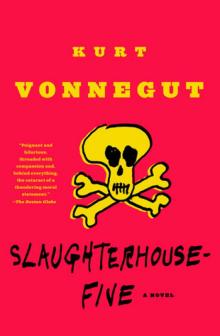 Slaughterhouse-Five
Slaughterhouse-Five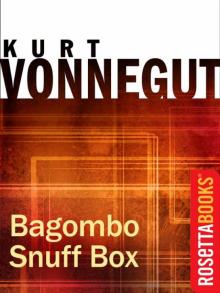 Bagombo Snuff Box: Uncollected Short Fiction
Bagombo Snuff Box: Uncollected Short Fiction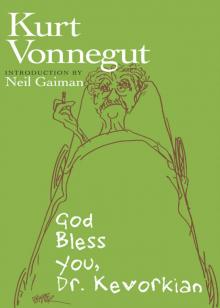 God Bless You, Dr. Kevorkian
God Bless You, Dr. Kevorkian Breakfast of Champions
Breakfast of Champions While Mortals Sleep: Unpublished Short Fiction
While Mortals Sleep: Unpublished Short Fiction Slapstick or Lonesome No More!
Slapstick or Lonesome No More! Cat's Cradle
Cat's Cradle The Sirens of Titan
The Sirens of Titan A Man Without a Country
A Man Without a Country Look at the Birdie: Unpublished Short Fiction
Look at the Birdie: Unpublished Short Fiction Bluebeard
Bluebeard Hocus Pocus
Hocus Pocus The Big Trip Up Yonder
The Big Trip Up Yonder Palm Sunday: An Autobiographical Collage
Palm Sunday: An Autobiographical Collage Jailbird
Jailbird Happy Birthday, Wanda June
Happy Birthday, Wanda June Welcome to the Monkey House
Welcome to the Monkey House Player Piano
Player Piano Fates Worse Than Death: An Autobiographical Collage
Fates Worse Than Death: An Autobiographical Collage Love, Kurt
Love, Kurt Timequake
Timequake God Bless You, Mr. Rosewater
God Bless You, Mr. Rosewater 2 B R 0 2 B
2 B R 0 2 B The Eden Express: A Memoir of Insanity
The Eden Express: A Memoir of Insanity Mother Night
Mother Night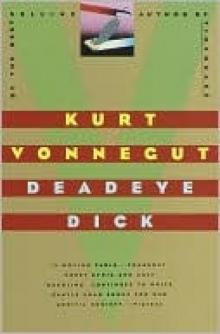 Deadeye Dick
Deadeye Dick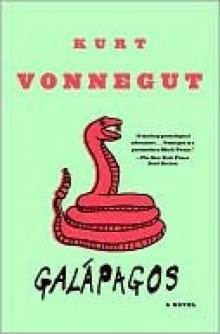 Galápagos
Galápagos Palm Sunday
Palm Sunday We Are What We Pretend to Be
We Are What We Pretend to Be Look at the Birdie
Look at the Birdie Basic Training
Basic Training Armageddon in Retrospect
Armageddon in Retrospect Basic Training (Kindle Single)
Basic Training (Kindle Single) If This Isn't Nice, What Is?
If This Isn't Nice, What Is? Bagombo Snuff Box
Bagombo Snuff Box The Petrified Ants
The Petrified Ants Cat's Cradle: A Novel
Cat's Cradle: A Novel Fates Worse Than Death: An Autobiographical Collage (Kurt Vonnegut Series)
Fates Worse Than Death: An Autobiographical Collage (Kurt Vonnegut Series)